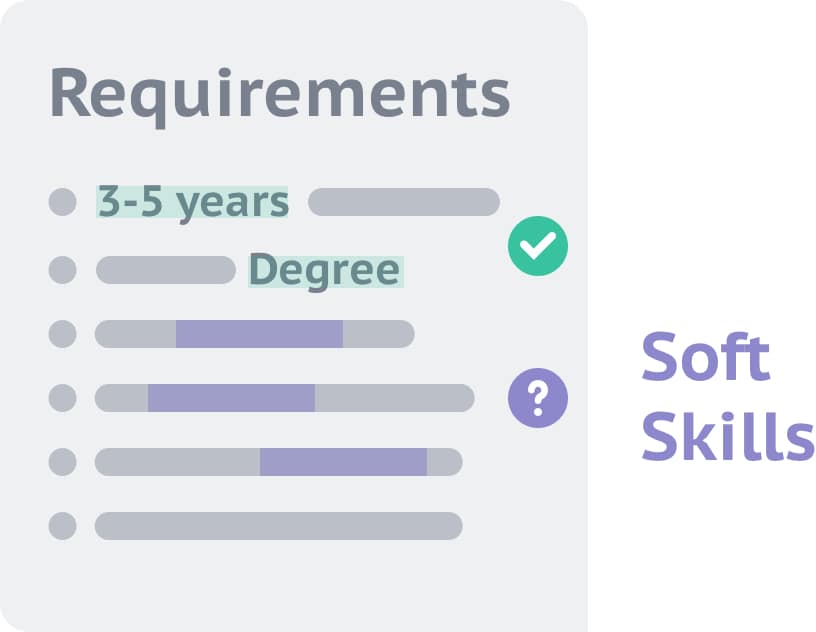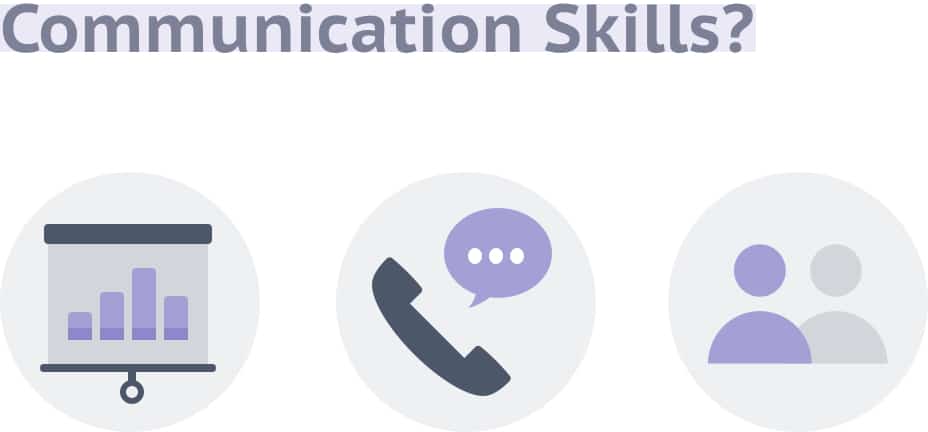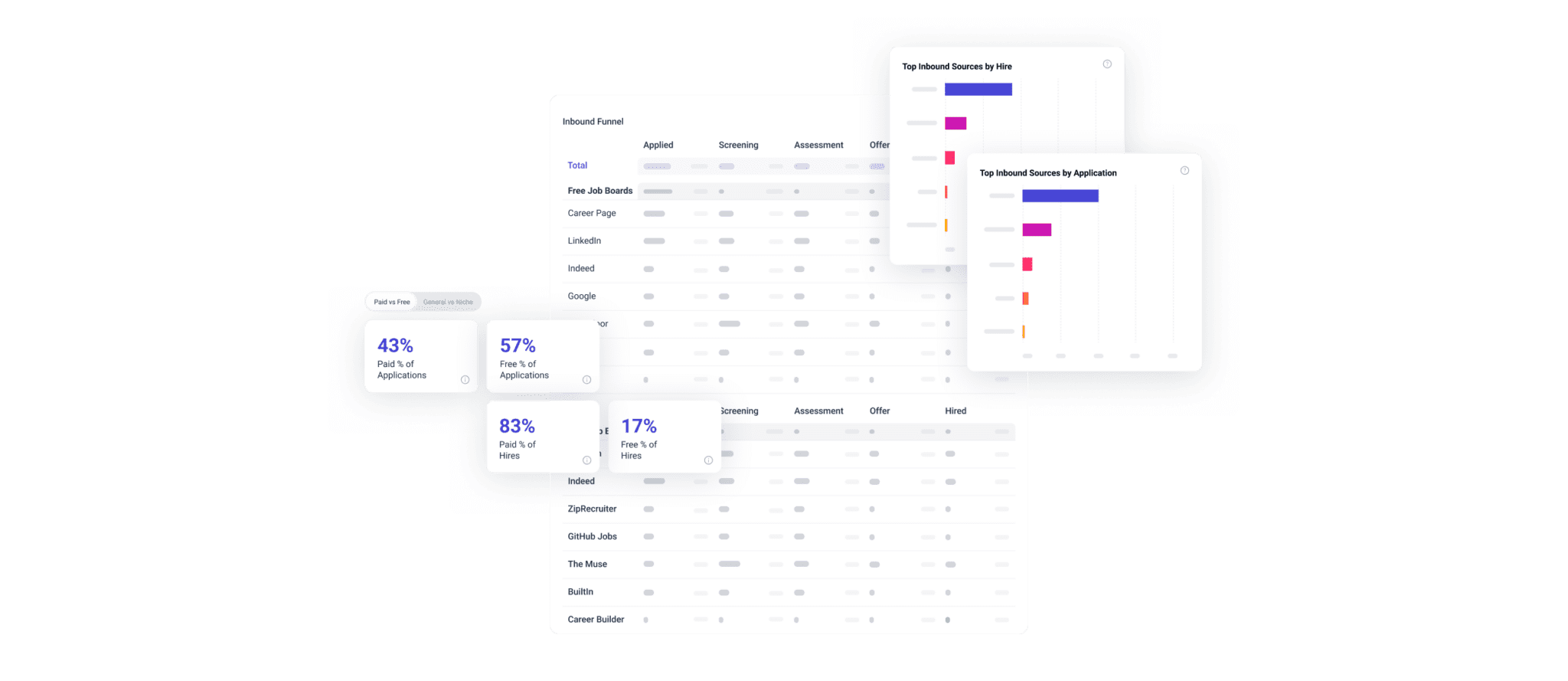Vague soft skills don’t add anything to your job descriptions except length and candidate confusion, resulting in a negative impact on the diversity and quality of your candidate pools.
It’s very common for hiring teams to include ambiguous soft skills such as “good communication skills” in the requirements section of their job descriptions. But it’s better to limit requirements to only those that are extremely clear and absolutely necessary to the role, and evaluate less specific soft skills during the interview process.
Why vague soft skills show up in job descriptions
Soft skills are things like ‘communication’ or ‘attention to detail’ or ‘problem-solving.’ While very common, they should be avoided within your job posts because their lack of clarity leaves too much room for interpretation and ultimately confuses candidates. Furthermore, highly qualified candidates are less likely to apply to positions with unclear or confusing soft skills in the requirements section of the job description.
As a hiring manager, writing great job descriptions isn’t easy, especially since most of the job descriptions out there provide a bad example by including soft skills.

Job description writers often start with obvious requirements like a specific degree and minimum years of experience. After that, though, it’s easy to add a laundry list of preferred or ambiguous soft skills that ultimately take away from the directness and brevity of the job post that can leave candidates scratching their heads.
Some low-impact requirements appear so often on job descriptions that writers might think they’re required skills. For example, “organizational skills” is arguably a requirement for any position at any company. Yet it still appears in job descriptions across all industries and countries, regardless of whether or not it is essential to the duties of the role.
Once we think about the “strong organizational skills” requirement more critically, however, we see how vague it is. We have other ways to determine a candidate’s organizational abilities, including specifically tailored interview questions (e.g., “How would you prioritize _____?”). If organization is critical to the role and it needs to be in the job description, replace the vague language with concrete, experience-based language (e.g. “Experience maintaining an organized sales pipeline in a CRM”).
Additionally, low-impact requirements can be hard to quantify across candidates. If they’re vague or too general, candidates (and hiring teams) will ignore them (which can lead to a lot of unqualified, one-click applications). Instead, candidates will use the concrete requirements to gauge whether they qualify for the role or not.
How soft skills confuse candidates
Candidates use the requirements and responsibilities sections as checklists for matching their skillset to the job. They typically don’t spend too much time mulling over your lists, and they may take a pass if they contain vague or confusing soft skills or if they’re too long.
Some of this can be very nuanced, but ‘communication skills’ offers a great example that shows up across all companies and industries.

Does ‘communication skills’ mean the ability to work across teams and manage relationships well? Or comfort delivering presentations to large groups? Or the sales chops needed to turn cold calls into leads?
If there’s a specific communication need, such as making presentations, by all means include that in the requirements section. But only as a specific need, which will make the requirement clear to job seekers. For example, you could turn “Excellent communication skills” for a Product Manager role into “Experience communicating complex technical concepts to a variety of audiences.” Without a special requirement, you should remove soft skills from the job description and instead assess them during interviews. Candidates appreciate shorter job descriptions, so feel free to use the delete button on all your low-impact requirements.
When to address soft skills (during the interview process)

Removing vague soft skills from job descriptions doesn’t mean removing them from your recruiting efforts entirely. On the contrary, you have the interview process to discover candidates’ soft skills.
Many companies have robust, public-facing core values such as ‘teamwork,’ ‘integrity,’ and ‘accountability.’ But these aren’t particularly compelling bullet points on a job description.
They are, however, important to convey to candidates, and the interview process offers a great time to do that. By engaging in a discussion of how company values relate directly to specific roles, you can get a sense of where candidates stand on those values. In fact, you can include their responses on interview scorecards or in the final hiring discussions.
3 pro tips
Being more specific about what a soft skill will look like in a particular role is a great way to add clarity to your job posts. Here are three other tips that can help you avoid using vague or confusing soft skills:
1) Turn skills that start with ‘Ability to’ into job responsibilities.
For instance, a copywriter should be able to write copy emails, websites, and the like. Instead of having the requirement “Ability to write copy” (which should be a given), try adding a bullet in the Responsibilities section along the lines of “You will write original, engaging copy for customer emails and other marketing materials.”
If you’d like this to remain in the Requirements section, you could reword it to focus more on experience rather than innate ability. So, instead of saying something like “Good copywriting skills,” try something like “Experience writing original, engaging copy for customer emails and other marketing materials”.
2) Avoid basic software requirements.
Job descriptions with basic requirements like ‘computer skills’ or ‘Microsoft Office’ attract fewer qualified candidates. Only list those that are actual requirements, and clarify the level of knowledge necessary.
If you’re hiring an accountant, for instance, Microsoft Excel is a likely requirement. But instead of listing ‘Excel,’ be specific about the experience level you need – for example: “Can write advanced macros.” This will help clarify the role for qualified candidates.
3) Show, don’t tell company culture.
Regardless of what you say about your company culture, candidates may learn more from the content included in or missing from your job descriptions.
Low-impact requirements, for one, are a red flag for candidates. They can signal a company culture that is lacking, too intense, or even unsupportive.
Also, too many soft skills can signal a bureaucratic or formal work environment. If that’s not true of your company, remove some from your job descriptions. Then incorporate a robust perks section that gives candidates a better window into your culture.
Ditch the vague soft skills for concrete, experience-based language
Ambiguous soft skills aren’t necessary in job descriptions despite so many including them. In fact, job descriptions that include them attract fewer, less diverse qualified candidate pools.
Instead, replace those innate soft skills with experience-based language that is directly correlated to the role. Or, try waiting until the interview process to bring them up. In the meantime, avoid basic software skills and tout your company culture with specifics. Also, turn ability-based requirements into job responsibilities while quantifying the requirements you do list.
Learn how Datapeople’s Smart Editor helps you replace vague soft-skills with specific, experience-based language.







